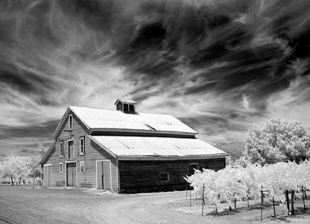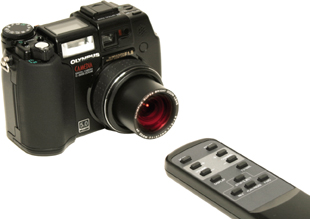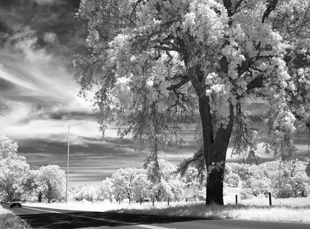Hack 25 Painless Infrared Photography
| < Day Day Up > |
| What kind of eerie world makes the sky go dark and trees turn white? It's the stunningly beautiful realm of infrared photography . If you've ever tried shooting and processing infrared film, you know what a pain in the aperture it is to deal with. You have to load the camera in complete darkness , guess wildly about the exposure settings, process the film, and then cross your fingers that at least one or two shots turned out the way you had hoped. The results could be stunning, but they came at a painful price. Digital photography has changed all that. Not only is persnickety film handling a thing of the past, but you also now get to preview your infrared images on the LCD monitor before taking the shot. And the best part? They will look every bit as beautiful as their film counterparts, as you can see in Figure 2-17, which was shot with a Canon G1 digital camera. This barn shot was taken at 1 p.m. Most photographers are diving for cover at this time of daythat is, unless they're shooting infrared. Figure 2-17. An infrared shot of a barn Infrared photography deals with the spectrum of light that you can't see but that your digital camera can. If you buy a filter to eliminate the normal light rays and capture only the infrared rays, you can add this look to your photographic bag of tricks. The first thing you'll notice in infrared photography is that the blue sky goes dark and that most trees turn very light. Glare is minimized, giving your pictures an eerie clarity. A popular filter for digicam infrared photography is the Hoya R72. If your camera accepts filters, then go get an R72 at the camera store, attach it to your camera, and look at a brightly lit scene in the LCD viewfinder. You'll know right away if your camera is suitable for this kind of shooting. You can test the "infraredness" of your camera by pointing a remote control toward the lens and seeing if the beam registers the camera's LCD monitor (Figure 2-18). Figure 2-18. Use a remote to test infrared capability What's interesting is that older digital cameras often work better than newer models. Over the years , many camera makers have added internal filtering to improve overall picture quality ( color , that is) that unfortunately hamstrings the camera's infrared capability. For example, my Canon G1 takes great infrared shots, but the G2, G3, and G5 don't perform nearly as well. This is a great argument for hanging on to your older digicams, because you never know what they'll be good for up the road.
Now, take your camera with a Hoya R72 filter out into the bright sunlight. The best conditions for infrared shooting are a blue sky, puffy clouds, and some trees in the landscape. Mount your camera on a tripod and put it in Program mode. You need to steady the camera because the shutter speeds will be very long, even in bright sunlight, due to the density of the R72 filter. Preview the scene in the LCD monitor and find a composition that best shows off the drama of infrared. Some trees will turn white and others won't, so you have to preview the scene to see what's most dramatic. Take a few shots, and then switch to B&W mode and take a few more. Later, while viewing the pictures on your computer, you can decide which type you like better. In Figure 2-19, the sky turns dark, the foliage light. What kind of weird world is this? Figure 2-19. Experimenting with infrared photography That's all there is to it. Now, during the bright midday sun, when other photographers refuse to go outside, you can create dramatic, artistic images that will truly impress your friends . |
| < Day Day Up > |
EAN: 2147483647
Pages: 161
